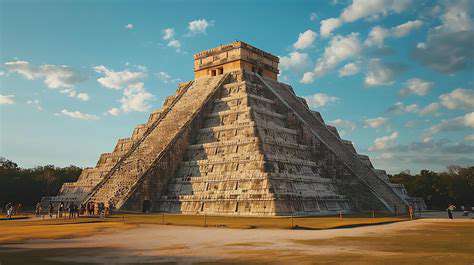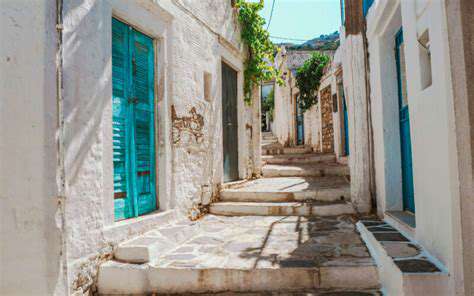Exploring Mayan Ruins in Mexico

Unveiling the Ancient City
Chichen Itza's sprawling archaeological complex showcases the Maya's architectural genius. This UNESCO World Heritage Site reveals layers of history through its blended architectural styles. The site's strategic location along ancient trade routes made it a cultural melting pot where Mayan, Toltec, and other Mesoamerican influences converged.
What makes Chichen Itza extraordinary isn't just its scale, but the precision of its construction. The pyramid's staircases contain exactly 365 steps (one for each day of the solar year), while shadow phenomena during equinoxes create the illusion of a serpent descending the northern staircase.
The Mystical Pyramid of Kukulkan
El Castillo (the Castle) demonstrates the Maya's architectural and astronomical sophistication. The pyramid's nine terraces likely represent the levels of the underworld in Mayan cosmology. Acoustic experiments reveal that handclaps at the base produce echo effects resembling the quetzal bird's call - a sacred sound in Mayan tradition.
The Sacred Cenote
The massive natural well at Chichen Itza served both practical and spiritual purposes. While providing vital water in the arid climate, it also became a focal point for offerings to the rain god Chaac. Modern dredging operations have recovered artifacts including gold ornaments and human remains, suggesting its role in important ceremonies.
The Great Ball Court
Chichen Itza's massive ball court (the largest in Mesoamerica) features remarkable acoustics - a whisper at one end can be clearly heard at the other. The stone rings set high on the walls represent a remarkable feat of engineering and athletic skill. Recent studies suggest the game may have involved predicting astronomical events through the ball's movements.
Preservation and Tourism
Managing visitor impact presents ongoing challenges. The site now restricts climbing certain structures to prevent erosion, while evening light shows minimize daytime crowding. Local guides provide invaluable context, sharing generations of oral history alongside archaeological findings.
Beyond the Hype: Discovering Hidden Mayan Gems

Unveiling the Hidden Potential
While major sites draw crowds, lesser-known ruins like Ek' Balam offer equally fascinating insights with more intimate exploration opportunities. These secondary sites often feature well-preserved stucco decorations and permit closer examination of architectural details. The real magic often lies in observing how smaller communities adapted Mayan urban principles to their local environments.
Navigating the Complexities
Understanding Mayan society requires moving beyond romanticized notions. Their achievements coexisted with periods of warfare and social stratification. Recent decipherment of glyphs reveals complex political dynamics between city-states, reminding us that ancient civilizations faced challenges similar to modern societies.
Exploring the Unforeseen Applications
Modern architects study Mayan building techniques for sustainable design solutions. Their use of ventilation shafts, rainwater collection systems, and passive cooling methods offer valuable lessons for contemporary construction in tropical climates.
Addressing the Ethical Considerations
Preservation efforts must balance scientific inquiry with respect for descendant communities. Some modern Maya view archaeological sites as sacred ancestral spaces rather than mere tourist attractions. Collaborative management approaches that include indigenous perspectives are becoming standard practice at many sites.
Bridging the Knowledge Gap
Interactive technologies now help visitors understand complex concepts like Mayan mathematics. Augmented reality apps can reconstruct painted facades on weathered ruins, while 3D printing allows tactile exploration of artifact replicas for visually impaired visitors.
Fostering Collaboration and Innovation
International research teams combine diverse specialties - from epigraphers deciphering glyphs to soil scientists analyzing ancient agricultural patterns. This multidisciplinary approach continues to yield fresh insights about Mayan achievements in fields ranging from medicine to urban planning.
Sneezing involves complex neuromuscular coordination. When nasal irritants trigger sensory nerves, signals travel to the brainstem which coordinates a sequence of muscle contractions. This reflex clears foreign particles while temporarily altering cardiovascular dynamics - an elegant example of the body's integrated systems.
Experiencing Mayan Culture: Beyond the Ruins
Unveiling the Ancient Cityscapes
Mayan archaeological zones reveal sophisticated urban planning principles. The careful orientation of buildings to celestial events, the engineered acoustics of plazas, and the integration of ceremonial and residential spaces all demonstrate thoughtful design. Modern visitors can best appreciate these sites by observing how structures relate to their surroundings and to each other.
Deciphering Mayan Hieroglyphs
The breakthrough in glyph interpretation came when scholars realized the writing combined logographic and phonetic elements. Today, about 85% of known glyphs can be read, revealing historical records, astronomical observations, and even poetry. Some sites offer workshops where visitors can practice writing basic glyphs using traditional tools.
Immersive Experiences: Beyond the Tourist Trail
Authentic cultural exchange might involve learning to prepare sikil pak (a pumpkin seed dip) from a local cook or trying backstrap weaving with a Mayan artisan. These hands-on experiences create deeper connections than passive observation. Many communities now offer homestays that provide insight into contemporary Mayan life while supporting local economies.
The Role of Nature in Mayan Life
The Maya viewed their environment as animate and sacred. Their forest gardens combined food production with biodiversity conservation - an early form of agroforestry. Traditional healers still use hundreds of plant species for medicinal purposes, preserving ancient botanical knowledge.
Preserving the Legacy for Future Generations
Responsible tourism means more than just not touching the ruins. It involves supporting local guides, purchasing authentic crafts directly from makers, and respecting ceremonial spaces. Some sites now limit daily visitors to reduce impact, while others have created digital documentation as preservation backups.











![How to Use Airport Lounges [Even Without Business Class]](/static/images/27/2025-06/StrategicPartnershipsandGuestPasses.jpg)